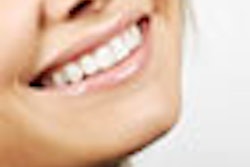
SAN DIEGO - A study presented today at the International Association for Dental Research (IADR) annual meeting that looked at the whitening efficacy of four different bleaching tray designs found all of them to be significantly effective.
Teeth whitening is a common and effective dental procedure, but it can cause significant pulpal and gingival irritation, said study author Michael Meharry, DDS, from Loma Linda University School of Dentistry.
Dr. Meharry told DrBicuspid.com that he and his colleagues wanted to see if different bleaching tray designs would be equally effective in whitening teeth, and, if so, whether there is a specific design that can be used to reduce pulpal and/or gingival irritation and sensitivity.
The researchers compared the whitening efficacy of four different bleaching tray designs using visual and digital spectrometer shade assessment.
They looked at 40 caries-free, shade A2 or darker human teeth that were mounted in a pink dental tray material to simulate natural gingival shape and color.
The teeth were placed in four simulated arches (groups of 10) with the following tray designs:
- Single-layer tray, scalloped, no reservoir
- Two-layer tray, with reservoir
- Two-layer tray, scalloped, no reservoir
- Two-layer tray, with reservoir and incisal vent
A bleaching gel of 15% carbamide peroxide was placed in the trays, which were then stored in a 100% humidity environment at 37° C to simulate body temperature for six hours, after which the teeth were removed, cleaned, and stored for 16 hours. This protocol was repeated to a total of 14 cycles.
The researchers used the Vita Classical shade guide and a spectrophotometer to measure tooth shades before bleaching and after 14 cycles.
Their findings included the following:
- There was a significant difference in whiteness (L) among the four different tray designs. All four designs were very effective in teeth whitening.
- The visual ordinal scale and the spectrophotometer results were highly correlated.
"This study showed all bleaching tray designs that were tested to be significantly effective," the authors concluded. "The visual ordinal scale is closely related to spectrophotometer in the L and A [redness] values."
An audience member asked Dr. Meharry if he had a preference among the tested tray designs.
Dr. Meharry responded that even though this issue has not yet been taken into clinical studies, he would probably prefer the two-layer tray with reservoir and incisal vent because it allows the excess bleaching material to escape instead of being forced down into the gingival margin area.
The information gained from this study can be used to design a clinical study that seeks to answer the question of whether a specific design can be used to reduce pulpal and/or gingival irritation and sensitivity, said Dr. Meharry.


















